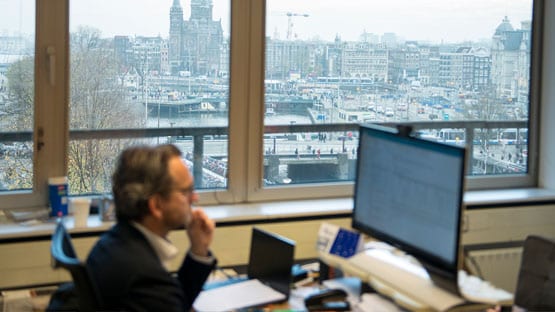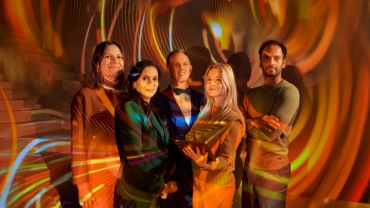
Growing their business, integrating their acquisitions, and building their organisation: 2019 will be another exciting year for albelli, one of Europe’s largest photo book suppliers. CEO Tristan Money and CFO Leon Kerckhaert tell us about their business priorities and the role digitalisation is playing in their customer-first company.
Scores of tourists are creating memories by taking photos and selfies in front of the entrance to Amsterdam Central Station. They are just a couple of steps away from the striking high-rise known as the ‘Silver Tower’, where albelli works to brighten up the world by bringing people’s moments to life. “Bringing people’s moments to life is actually what we do,” says albelli’s CFO and former PwC employee Leon Kerckhaert. “We make it possible for people to do something with their photos. Relive moments and share memories and experiences with others. In fact, we’re not really selling products; we’re selling emotions.”

Tristan Money (CEO) en Leon Kerckhaert (CFO)
From pioneer to professional organisation
Albelli was founded in 2003, as ‘Albumprinter’, and it was the first company in Europe with an online tool that allowed consumers to create and produce photo books themselves. Vistaprint (since 2014: Cimpress, ed.) took over the company in 2011 and in 2017 private equity house Gilde Buy Out Partners and albelli’s leadership team bought out Cimpress. “I started working at albelli in 2010,” says Kerckhaert. “The company was just coming out of its pioneering phase and we had to make sure that our internal organisation was actually keeping up with current growth while supporting further growth ahead. Since then, it’s been a virtual rollercoaster in terms of acquisitions, exits, joining an American business (Cimpress, ed.), and the buy-out in 2017. A lot of things changed at Cimpress between the time we were acquired in 2011 and our exit last year. From a strategic perspective, the fit was no longer there. It was better for Cimpress but also for albelli to part ways.”


Acquisition of ReSnap and monAlbumPhoto
Three years ago, albelli was still very much focused on the Benelux and Scandinavia. The company has since broadened its scope. “If you check out our Amsterdam office,” says Money, “you’ll see that about a third of our employees are Dutch, with the rest coming from more than 30 different countries around the world. We bring different people with different talents, mindsets and market experiences together.” Kerckhaert: “We are now expanding beyond the European countries where we are already big. We’ve made significant progress growing our business not only in Europe but also in the USA and Oceania.” Money: “In the last fourteen months we acquired two companies. One is a technology company, ReSnap, which is all about artificial intelligence and will help us make it easier for customers to create a photo book. The other – and this plays into our international ambitions – is monAlbumPhoto, the second largest online photo product company in France. That’s a lot of change to deal with in one year.”
Three companies in one
In fact, albelli is three companies in one. Kerckhaert: “On the one hand, we’re a clear business-to-consumer e-commerce company, with a web shop where customers can place orders. On the other, we have a well-staffed IT development organisation to make sure that we have the best software tools available so that people can actually build products. And then there’s our printing production facilities. All three need to work hand-in-hand to deliver the right quality product and the right experience for customers. It’s quite a challenge getting this right. Our e-commerce is in the cloud, it’s everywhere, but the majority of our developers are right here in Amsterdam and Nijmegen, some are in Bergen (Norway) and others in Paris. Our production centre is in Ypenburg and now that we’ve acquired monAlbumPhoto, we have a second plant near Paris. So there’s a lot of complexity to manage from a location perspective as well, to get everyone aligned and on the same page.”
“We own the manufacturing,” adds Money. “That allows us to control quality, delivery and service. If we run into a delay in the manufacturing process, for example, or in delivery because of carrier issues, we at least have enough control to communicate that to our customers. A lot of companies in our industry outsource manufacturing, which may make things simpler for them but doesn’t allow them to control the customer experience, which is really important.”
Who are your biggest competitors?
Money: “Across Europe our biggest competitor is a company called CeWe – which is very dominant in Germany, but also very present in other markets – and PhotoBox, another big player, very dominant in the UK and France. There is also still business activity offline in some markets, through retailers, and we also compete with them. We set ourselves apart by making it easy for our customers. We have a whole range of photo products, but our primary product is the photo book. Historically, it takes ten days on average for people to create a photo book online. That’s a lot of time and effort, and many people simply drop out. So our whole focus has been ‘how do we make this process as easy as possible?’ Instead of making the process ten percent quicker every year, for example by cutting it from ten days to nine, we ask ourselves why it should take more than five minutes in the first place.”

“The challenge is to identify the really important moments, whether it’s a wedding, the birth of a child, or a company party. We believe we can translate those moments into physical products.”

“We make it possible for people to do something with their photos. Relive moments and share memories and experiences with others. In fact, we’re not really selling products; we’re selling emotions.”
- And that’s where the acquisition of ReSnap technology came in?
“ReSnap is completely rethinking the way we do things,” Money explains. “They came up with the idea of using artificial intelligence to create a photo book in less than two minutes. We launched this concept across markets, but we’re also incorporating a lot of the technology into our own editor software. There are a lot of people who still enjoy the creative process of making a photo book, but even there you have to ask yourself: how can we make it easier for them to select or lay out their photos while still giving them creative control.”
Kerckhaert: “ReSnap was focused on IT development but not on taking their ideas to the market, with all the necessary investments involved. That’s when we started talking to them. Basically, there are two components. One is to select or rate the photos on the basis of quality or emotional response. The second is to lay out the photographs automatically in the specific product, in this case a book, which the user can then view in a minute or two. The user then has the opportunity to make changes, but if he doesn’t want to, he’s done. Within a minute! It’s a sort of self-learning tool; it learns from the photos selected by customers and the changes they’ve made. At some point, people can just upload their photos and the tool selects the best and creates the product automatically for them.”
“Digital photography and digital sharing are growing a lot faster than traditional photography and physical prints,” says Money. “The challenge is to identify the really important moments, whether it’s a wedding, the birth of a child, or a company party. We believe we can translate those moments into physical products.”
Rising customer expectations
Being a customer-first company means learning as much as possible about your customers and adapting your strategy accordingly. Customer expectations continue to rise year upon year. “If we just stick to the status quo with our customers, we will not meet their rising expectations,” says Money. “Our major focus is how we can delight our customers. They expect great quality, they expect us to deliver fast and on time. Speed of delivery is also linked to quality; people perceive it as part of your overall quality.”
“People tend to forget that we offer mass customisation,” says Kerckhaert. “They expect that if they place an order, they’ll get the product first thing in the morning or even the same evening. But every product is different, and it still needs to be made to order. That takes time, but I think going forward that we can optimise the production process and that might be a key differentiator in the future.”
“We get to know our customers by talking to them live through our customer services,” says Money. “We conduct studies on our customers, whether that involves looking at internal or external data, and linking them to external trends. This is another area where we really think we can differentiate ourselves from our competitors, by knowing who our customers are and being able to adapt our strategy accordingly across markets and both new and repeat customers. We’re developing our overall data architecture to give our customers a truly relevant and tailor-made experience. That’s another big area that we have focused on internally over the past year, moving from a more static environment to a view where all of the data can be collected, whether from manufacturing, customer services or what’s happening on the website.”


- Finally, what trends are you following?
“Overall, we keep very close track of trends,” says Money, “but we are also very clear about the choices we’re making now versus the things we see on the horizon. One very good example is voice. It’s a very big trend but we’ve decided that it’s not a focus for us this year. That doesn’t mean that we don’t see voice in our future. Mobile is front and centre for everyone who works here. Our website and e-mail designs have been optimised for mobile devices. We have a mobile app, which is very popular, particularly for photo books. But mobile adoption varies considerably across markets, products, new customers and repeat customers. For example, the majority of our existing customers in the Netherlands who are used to ordering on a desktop continue to do so. When we look at new customers, however, many are ordering on their mobile device. We have some markets where mobile accounts for over 30% of our sales, but when we break it down further and look at our new customers, mobile accounts for as much as 60% or 70%. For quick and easy products like prints or wall décor, people are much more comfortable ordering on their mobile device, whereas they may think twice about the device they order a photo book on. Our Dutch market is way less seasonal than any other market. Photo books are not such a seasonal product, but if you look at a fast-growing category for us – photo calendars and Christmas cards – 80-90% of the demand comes in a three-week period. November and December are the biggest months of the year. Accelerating in those products automatically makes our business more seasonal, but ideally we’ll be able to spread the demand throughout the year to make full use of our printers.”
Contact

















